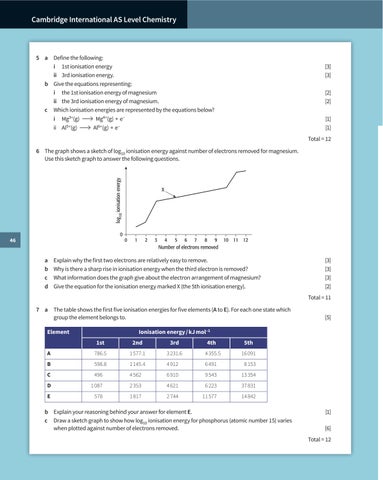Cambridge International AS Level Chemistry
5 a Define the following: i 1st ionisation energy ii 3rd ionisation energy. b Give the equations representing: i the 1st ionisation energy of magnesium ii the 3rd ionisation energy of magnesium. c Which ionisation energies are represented by the equations below? Mg4+(g) + e– i Mg3+(g) Al6+(g) + e– ii Al5+(g)
[3] [3] [2] [2] [1] [1] Total = 12
log10 ionisation energy
6 The graph shows a sketch of log10 ionisation energy against number of electrons removed for magnesium. Use this sketch graph to answer the following questions.
0
46
a b c d
X
0
1
2
3
4 5 6 7 8 9 10 11 12 Number of electrons removed
Explain why the first two electrons are relatively easy to remove. Why is there a sharp rise in ionisation energy when the third electron is removed? What information does the graph give about the electron arrangement of magnesium? Give the equation for the ionisation energy marked X (the 5th ionisation energy).
[3] [3] [3] [2] Total = 11
7 a The table shows the first five ionisation energies for five elements (A to E). For each one state which group the element belongs to.
[5]
Ionisation energy / kJ mol–1
Element 1st
2nd
3rd
4th
5th
A
786.5
1 577.1
3 231.6
4 355.5
16 091
B
598.8
1 145.4
4 912.8
6 491.8
8 153
C
496.8
4 562.8
6 910.8
9 543.8
13 354
D
1 087.8
2 353.8
4 621.8
6 223.8
37 831
E
578.8
1 817.8
2 744.8
11 577.8
14 842
b Explain your reasoning behind your answer for element E. c Draw a sketch graph to show how log10 ionisation energy for phosphorus (atomic number 15) varies when plotted against number of electrons removed.
[1] [6] Total = 12
